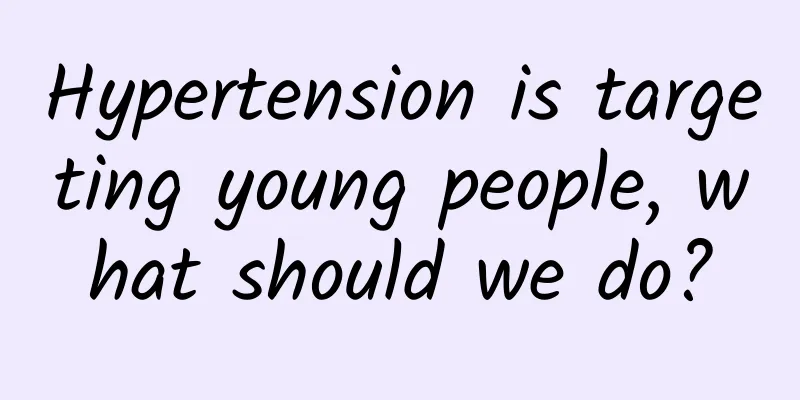Hypertension is targeting young people, what should we do?

|
Hypertension is a common disease and the most important risk factor for cardiovascular and cerebrovascular diseases. It is called the "invisible killer" that affects human health. To this end, the World Health Organization and the International Federation of Cardiology have designated May 17th of each year as "World Hypertension Day" to better arouse people's attention to the prevention and treatment of hypertension worldwide. In my country, hypertension has the characteristics of "three highs" - high prevalence, high disability rate, and high mortality rate, and "three lows" - low awareness rate, low treatment rate, and low control rate, which seriously threatens the health of the Chinese people. At the same time, in recent years, with the rapid development of the economy and changes in lifestyle, hypertension is no longer a "patent" of the middle-aged and elderly. A survey shows that the prevalence of hypertension in people aged 35-44 is about 15%, and more and more young people have become the "reserve army" of hypertension patients. Diagnostic criteria for hypertension In the absence of antihypertensive drugs, if the systolic blood pressure is ≥140 mmHg and/or the diastolic blood pressure is ≥90 mmHg when measured in the clinic three times on different days, hypertension can be diagnosed. If blood pressure is measured continuously and standardizedly at home for 5-7 days and the average blood pressure is ≥135/85 mmHg, hypertension can be diagnosed. Hypertension is one of the most common chronic diseases and the most important risk factor for the onset and death of coronary heart disease, stroke, chronic kidney disease, etc. Deaths caused by cardiovascular and cerebrovascular diseases in my country account for more than 40% of the total deaths of residents, and about 70% of stroke deaths and about 50% of myocardial infarctions are closely related to hypertension. What are the characteristics of hypertension in young people? 1. Symptoms are atypical and are often discovered during physical examinations or accidental measurements. 2. Most of them are mild hypertension. 3. The diastolic blood pressure is mainly elevated, while the systolic blood pressure is mostly normal or slightly elevated. 4. The proportion of patients with overweight/obesity and metabolic disorders is high. 5. Insufficient awareness of the harm of the disease, low treatment rate, and even lower control rate. 6. Longer life expectancy and higher lifetime risk of cardiovascular disease. How to choose antihypertensive drugs for young people with hypertension? In addition to genetic and environmental factors, young hypertensive patients often have increased sympathetic nerve activity, which further activates the renin-angiotensin system, resulting in increased blood pressure and heart rate. Studies have found that 64% of hypertensive patients over the age of 40 have over-activation of the sympathetic nerves. The stronger the activity of the sympathetic nervous system, the faster the heart rate, and the higher the risk of cardiovascular and cerebrovascular diseases. The use of drugs that inhibit the sympathetic nerves and renin-angiotensin system blockers can help control hypertension in young people and reduce the occurrence of malignant events such as myocardial infarction, stroke, and even sudden death. Beta-blockers are the only antihypertensive drugs that can both lower blood pressure and slow heart rate. They are the preferred antihypertensive drugs for young patients with hypertension, especially for patients with significant sympathetic nerve activation (such as resting heart rate > 80 beats/min). Currently, commonly used beta-blockers in clinical practice include bisoprolol, metoprolol, labetalol, etc., but they are contraindicated in patients with bronchial asthma, acute heart failure, severe sinus bradycardia, and high-degree atrioventricular block. In addition, renin-angiotensin system blockers such as angiotensin-converting enzyme inhibitors (prils) or angiotensin receptor antagonists (sartans) can also be used as first-line antihypertensive drugs for young patients with hypertension, especially for patients with concomitant diabetes and proteinuria. What are the treatment goals for young patients with hypertension? For young hypertensive patients without complications, it is recommended to lower blood pressure to <140/90 mmHg and control heart rate at rest at 60-75 beats/min; if tolerated, blood pressure can be further lowered to <130/80 mmHg. For patients with coronary heart disease and chronic heart failure, if tolerated, it is recommended to control blood pressure to <130/80 mmHg and resting heart rate to 55-60 beats/min. Precautions for antihypertensive treatment in young patients with hypertension 1. For patients with poor medication compliance and prone to missed doses, it is recommended to give priority to the use of long-acting antihypertensive drugs taken once a day. 2. Labetalol hydrochloride is preferred for young female patients who are pregnant or planning to become pregnant. 3. Closely monitor blood pressure and heart rate during medication, and observe for adverse reactions such as fatigue, cold extremities, and decreased libido. 4. Patients who have been using beta-blockers for a long time should not stop taking the medication suddenly and should adjust the dosage according to the doctor's advice. 5. For patients with poorly controlled blood pressure or high-risk cardiovascular disease, a combined antihypertensive treatment program should be initiated. 6. Patients with diabetes or metabolic syndrome should be cautious when using beta-blockers and diuretics together. Prevention of Hypertension 1. Limit sodium intake: A high-salt diet significantly increases the risk of hypertension. Adults should not consume more than 5 grams of salt per day. Increase potassium-rich foods such as fresh vegetables and fruits. 2. Reduce high-sugar and high-fat diets: limit the use of cooking oil, eat less fast food, and try to eat at home. 3. Weight control: Maintain body mass index (BMI) <24kg/m2, waist circumference <90cm for men and <85cm for women 4. Regular exercise: Encourage aerobic exercises such as brisk walking, jogging, swimming, and cycling for 30 minutes a day, 5 to 7 times a week. 5. Quit smoking and limit alcohol consumption: Smoking is harmful to health, smokers should quit smoking as soon as possible. Limit alcohol intake to <25g/day for men and <15g/day for women. 6. Reduce mental stress: maintain psychological balance and a good mood, and seek professional psychological counseling when necessary. |
<<: This fruit is sweet, low in calories, and the best for hydration (not watermelon)
Recommend
What to do if your period is late
There are two main reasons for delayed menstruati...
How many days after medical abortion?
Most women who have an unexpected pregnancy will ...
Symptoms of metrorrhagia
The menstrual period is very difficult for every ...
Pink blood after sex
During sexual intercourse, both men and women mus...
What to eat during breastfeeding to reduce internal heat the fastest
Many pregnant women do not pay attention to their...
My period is six days late.
In life, delayed menstruation is a very common ph...
Can inverted nipples be sucked out?
Nipple inversion is a dent in the normal part of ...
Silver Age Health | What should the elderly pay attention to in their daily oral care?
We often hear the saying: "Good teeth mean a...
Can I eat peach gum, saponin and rice snow swallow during pregnancy?
Everyone who eats peach gum snow swallow hopes th...
What medicine is better for women to delay aging?
When people reach a certain age, they will find t...
Hematoma but no bleeding
Some women will experience many sequelae after a ...
If a woman has freckles, will it be passed on to her children?
Freckles on many people are not caused by poor sk...
Does an enlarged uterus affect pregnancy?
Uterine hypertrophy is a common cervical disease ...
What to do if uterine adhesions occur after uterine curettage
In many cases, a uterine curettage is required, m...
What to do if your gums bleed after childbirth
Everyone should be familiar with bleeding gums. T...









